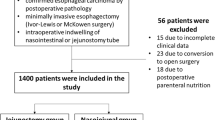Abstract
In esophageal cancer treatment, nutrition by feeding tube has been demonstrated to improve patient tolerance of treatment, quality of life, and long-term outcomes. The open gastrostomy and percutaneous endoscopic gastrostomy (PEG) using introducer technique are procedures that avoid cancer cells seeding and also improve patient’s nutritional status, hydration, and medication. The aim of this study is to compare the results of the introducer PEG and open gastrostomy in patients with advanced esophageal cancer. A retrospective study was analyzed in the advanced esophageal cancer patients who indicated and received feeding support between January 2016 and December 2017. Twenty-eight patients in introducer PEG and 36 patients in open gastrostomy presented the following comparative data: mean operative duration time shorter, less pain score, and shorter hospitalization in introducer PEG than open gastrostomy. Both groups showed no readmission or 30-day mortality. The adverse events of open gastrostomy demonstrated higher than introducer PEG group. Both introducer PEG and open gastrostomy were the safe options for advanced esophageal cancer patients indicating for enteral feeding and to avoid cancer cell seeding but the introducer PEG demonstrated the effective minimally invasive procedure with fewer complications.
Similar content being viewed by others
References
Bray F, Ferlay J, Soerjomataram I, Siegel RL, Torre LA, Jemal A. Global cancer statistics 2018: GLOBOCAN estimates of incidence and mortality worldwide for 36 cancers in 185 countries. CA Cancer J Clin. 2018;68(6):394–424.
Chaiwerawattana A, Sangrajrang S, Laowahutanon P, Phetrit W. Hospital-base cancer registry 2015. Bangkok: Pornsup printing Co. Ltd; 2017.
Jordan T, Mastnak DM, Palamar N, Kozjek NR. Nutritional therapy for patients with esophageal cancer. Nutr Cancer. 2018;70(1):23–9.
Gauderer MW, Ponsky JL, Izant RJ Jr. Gastrostomy without laparotomy: a percutaneous endoscopic technique. J Pediatr Surg. 1980;15:872–5.
Cappell MS. Risk factors and risk reduction of malignant seeding of the percutaneous endoscopic gastrostomy track from pharyngoesophageal malignancy: a review of all 44 known reported cases. Am J Gastroenterol. 2007;102(6):1307–11.
Sousa AL, Sousa D, Velasco F, Açucena F, Lopes A, Guerreiro H. Rare complication of percutaneous endoscopic gastrostomy: ostomy metastasis of esophageal carcinoma. World J Gastrointest Oncol. 2013;5(11):204–6.
Sinapi I, Navez B, Hamoir M. Seeding of the percutaneous endoscopic gastrostomy site from head and neck carcinoma: case report and review of the literature. Head Neck. 2013;35(7):E209–12.
Köhler G, Kalcher V, Koch OO, Luketina RR, Emmanuel K, Spaun G. Comparison of 231 patients receiving either “pull-through” or “push” percutaneous endoscopic gastrostomy. Surg Endosc. 2015;29(1):170–5.
Adelson RT, Ducic Y. Metastatic head and neck carcinoma to a percutaneous endoscopic gastrostomy site. Head Neck. 2005;27(4):339–43.
Tucker AT, Gourin CG, Ghegan MD, Porubsky ES, Martindale RG, Terris DJ. ‘Push’ versus ‘pull’ percutaneous endoscopic gastrostomy tube placement in patients with advanced head and neck cancer. Laryngoscope. 2003;113(11):1898–902.
Okumura N, Tsuji N, Ozaki N, Matsumoto N, Takaba T, Kawasaki M, et al. Percutaneous endoscopic gastrostomy with Funada-style gastropexy greatly reduces the risk of peristomal infection. Gastroenterol Rep (Oxf). 2015;3(1):69–74.
National Comprehensive Cancer Network. NCCN clinical practice guidelines in oncology: Esophageal and Esophagogastric junction Cancers, version 2[Internet]. Fort Washington, PA: National Comprehensive Cancer Network; 2018. http://www.nccn.org/professionals/physician_gls/pdf/esophageal.pdf. Accessed Jan 3 2019.
Kitagawa Y, Uno T, Oyama T, Kato K, Kato H, Kawakubo H, et al. Esophageal cancer practice guidelines 2017 edited by the Japan Esophageal Society: part1. Esophagus. 2018 Aug 31. https://doi.org/10.1007/s10388-018-0641-9.
Kitagawa Y, Uno T, Oyama T, Kato K, Kato H, Kawakubo H, et al. Esophageal cancer practice guidelines 2017 edited by the Japan Esophageal Society: part2. Esophagus. 2018 Aug 31. https://doi.org/10.1007/s10388-018-0642-8.
Bravo JG, Ide E, Kondo A, de Moura DT, de Moura ET, Sakai P, et al. Percutaneous endoscopic versus surgical gastrostomy in patients with benign and malignant diseases: a systematic review and meta-analysis. Clinics (Sao Paulo). 2016;71(3):169–78.
Acknowledgements
The authors would like to thank Dr. Jirawat Swangsri (Department of Surgery, Siriraj Hospital, Mahidol University) for technical assistance with the introducer PEG procedure and Norman Mangnall for assistance in editing the English version of this manuscript.
Disclosures
Authors have nothing to disclose.
Author information
Authors and Affiliations
Corresponding author
Ethics declarations
Conflict of interest
The authors declare no conflict of interest.
Ethical Approval
All procedures performed in studies involving human participants were in accordance with the ethical standards of the institutional and/or national research committee and with the 1964 Helsinki declaration and its later amendments or comparable ethical standards. This study passed the ethical research process from Human Ethics Committee of Thammasat University (Faculty of Medicine) with reference number; MTU-EC-SU-0-009/61.
Informed Consent
Informed consent was obtained from all individual participants included in the study.
Additional information
Publisher's Note
Springer Nature remains neutral with regard to jurisdictional claims in published maps and institutional affiliations.
Rights and permissions
About this article
Cite this article
Mahawongkajit, P., Techagumpuch, A., Limpavitayaporn, P. et al. Comparison of Introducer Percutaneous Endoscopic Gastrostomy with Open Gastrostomy in Advanced Esophageal Cancer Patients. Dysphagia 35, 117–120 (2020). https://doi.org/10.1007/s00455-019-10017-w
Received:
Accepted:
Published:
Issue Date:
DOI: https://doi.org/10.1007/s00455-019-10017-w




